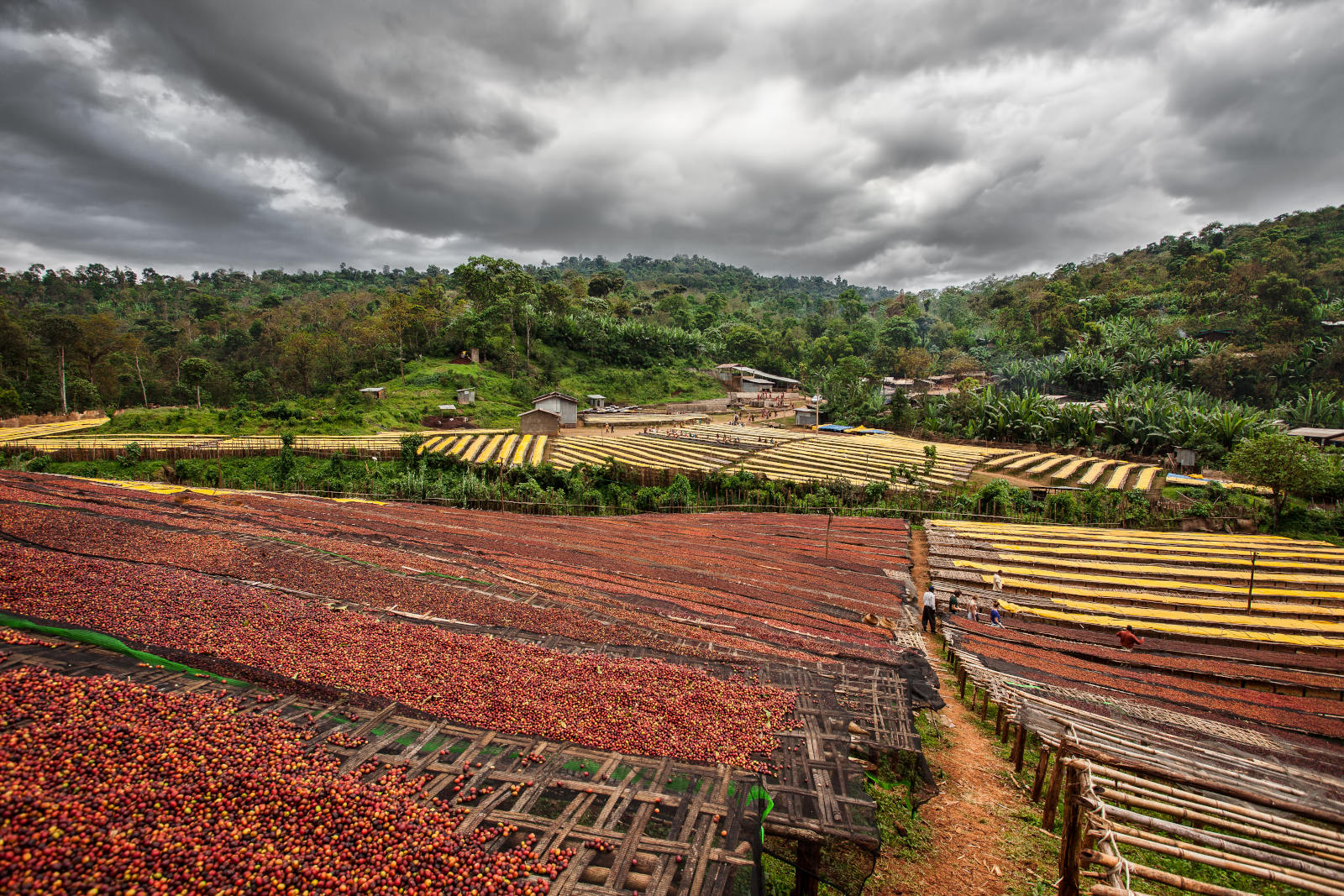
Coffee and the plantations
GREEN HILLS,
BLUE SKIES
AND BRIGHT RED BERRIES.
It is the force of nature, of earth, of man.
EVERYTHING STARTS FROM THE EARTH AND RESPECTING ITS RHYTHMS
Coffee requires a long production time. It begins with the seed that turns into a small coffee plant, which after a few years starts to bear fruit.
Enter the places of origin of the coffees we use:
“From a scented white flower to a ripen and juicy red berry;
of this splendid fruit, we use the seed”

Coffee berries
Coffee has ancient origins with many social meanings.
In addition to Homer’s citations, there are popular folktales that mention it, the most famous of which is probably the “Dancing Goats and Dancing Dervishes”.
The story, set in the 8th century A.D., tells of an Abyssinian goatherd named Kaldi (or Khalid), who went to graze his flock outside Mocha, a city in Yemen. He saw his flock of goats dancing like crazy after foraging all night on the red berries from a large bush growing abundantly in the area.
The goatherd, surprised and curious, gathered some berries and brought them to the monastery in Cheodet to learn their secret.
At the monastery the prior, Abbot Yahia, did not believe the goatherd and fearing it was the devil’s work, he threw the berries into the fire.
The berries, once roasted, unexpectedly released an intense and pleasant aroma.
It is more probable that the Arabic name comes from Kaffa, a region in Ethiopia where a variety of coffee grows spontaneously.
The abbot collected the berries and put them in water to cool. That is how a black drink with a very pleasant taste was obtained and be given to the monks at the monastery so that they regained strength and could pray all night long without falling asleep.
This drink was called “kahwa“.


The plantations
Coffee plants are cultivated in the band between 25° latitude north and 25° latitude south, where the temperature, sunlight and nature of the soil are ideal for their growth.
When the green fruits ripen into bright cherry red fruits the coffee beans are removed and are then dried in the sunlight.
Of the some sixty species of coffee, only twenty-five of them are widely traded for their fruit; of these only the first four hold top positions for the coffee bean trade: Coffea Liberica and Coffea Excelsa and the most common and important Coffea Arabica and Coffea Robusta.
Though belonging to the same botanical family, these two species have different properties that define completely different flavors.

The Arabica variety is qualitatively better and represents about 70 percent of the world production.
Its long oval round beans have an intense aromatic perfume.
The Arabica plants grow better in high-mineral soils, especially those of volcanic origin over six hundred mt. above sea level.
The ideal climate should have an average temperature of 20 °C so that the beans ripen slowly, developing what once roasted become sweet, smooth flavors.
“Travelling in the lands where coffee grows teaches us to value our product even more.”
Similar to Coffea Arabica, the Robusta variety has branches that curve downwards, into the shape of an umbrella.
It flowers three times a year.
Its irregular round yellow-green beans are smaller and contain more caffeine compared to the previous species. Once roasted, they give rise to a sharp bitter flavor.






HARVESTING AND PROCESSING
There are two methods for picking coffee: selective picking or strip picking. The first is a selective harvesting where only the ripe coffee berry are hand-picked; it is all in the experience, in the eyes of the picker. Only ripe berries are picked, then returning several times to pick the remaining berries as they ripen.
In strip picking, trees are harvested entirely at one time, stripping all the beans off the branches, even unripe berries. In the wide lands of Brazil, the first coffee producer worldwide, machine harvesting is often used.
Coffee can then be processed in various ways: dry, semi-washed or washed.
In the dry method, or “natural coffee method”, the fresh picked berries are dried under the sun. Once the berry is dry, the outer shell is removed .
In the washed coffee method the outer layer of the berries is removed from the beans with a pulping machine; the beans are then washed and stored in fermentation tanks. The berries are then dried in the sun in their parchment skin (also called pergamino), that is the last layer surrounding the bean to protect it against humidity and preserve the bean from breaking.
the travel
Travelling in the lands where coffee is born is an enriching experience: visiting the places and meeting the people, their cultures and their smiles.
When we meet the people and learn about their work and their languages, we learn the know-how, we become aware. It becomes knowledge, not merely information and data.
It is an opportunity to see how the coffees we use are processed to obtain our blends; an opportunity to select those coffees that will become our strength. The quality of coffee depends on many factors: where it is grown, how it is looked after, processed, washed, dried, selected in all the different phases.
